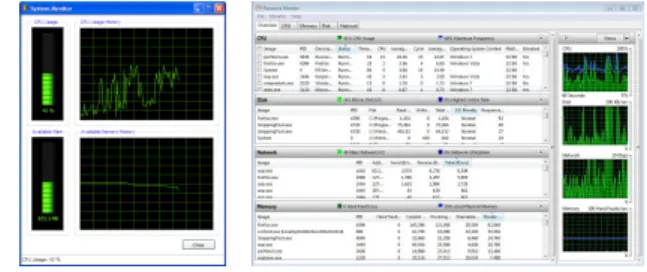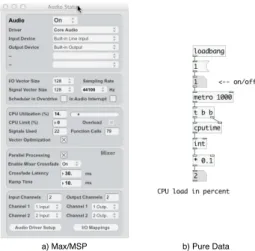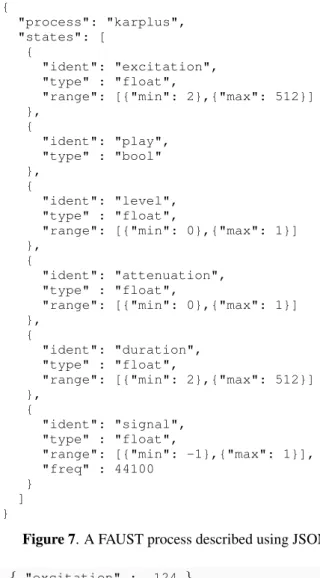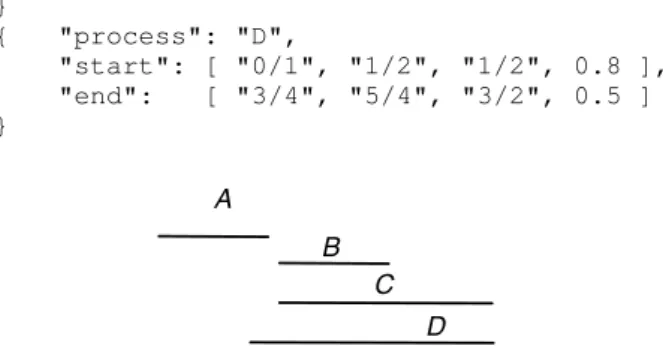HAL Id: hal-01068064
https://hal.archives-ouvertes.fr/hal-01068064
Submitted on 24 Sep 2014
HAL is a multi-disciplinary open access
archive for the deposit and dissemination of
sci-entific research documents, whether they are
pub-lished or not. The documents may come from
teaching and research institutions in France or
abroad, or from public or private research centers.
L’archive ouverte pluridisciplinaire HAL, est
destinée au dépôt et à la diffusion de documents
scientifiques de niveau recherche, publiés ou non,
émanant des établissements d’enseignement et de
recherche français ou étrangers, des laboratoires
publics ou privés.
Representation of Musical Computer Processes
Dominique Fober, Yann Orlarey, Stéphane Letz
To cite this version:
Dominique Fober, Yann Orlarey, Stéphane Letz. Representation of Musical Computer Processes.
Joint Conference ICMC / SMC 2014, Sep 2014, Athens, Greece. pp.1604-1609. �hal-01068064�
Representation of Musical Computer Processes
Dominique Fober, Yann Orlarey, St´ephane LetzGRAME
Centre national de cr´eation musicale Lyon, France
fober@grame.fr orlarey@grame.fr letz@grame.fr
ABSTRACT
The paper presents a study about the representation of mu-sical computer processes within a music score. The idea is to provide performers with information that could be use-ful especially in the context of interactive music. The paper starts with a characterization of a musical computer pro-cess in order to define the values to be represented. Next it proposes an approach to time representation suitable to asynchronous processes representation.
1. INTRODUCTION
Throughout the last decades, the development of electronic and digital technologies, including sound production, ges-ture captation, has led to a musical revolution and to the emergence of new genres firmly established in the cul-ture and musical imagination. From these evolutions, new needs have emerged, notably in terms of music notation and representation [1]. Raised by artistic forms like inter-active music or live coding, questions related to dynamic notation or musical process representation are taking a sig-nificant importance. With interactive music, the cohabita-tion between static scores and interaccohabita-tion processes is to be organized. With live coding, the border between pro-grammation and score tends to be blurry [2]. Today, the object of the musical notation needs to be redefined to take account of the new dimensions of the current artistic prac-tices.
This paper addresses the dynamic representation of pro-cesses and their states in the single graphical space of the musical score.
The musical context gives a specific dimension to the problematic of a process representation, because we are interrested in its current state, but also in a set of time or-dered states, including futur possible states. Usability con-straints require these state to be readable in real-time, i.e. in the time of the score performance, and to be a guide for the interaction choices of the performer.
The objective of the study is to integrate the representa-tion of processes to INScore [3, 4], an environment for the design of augmented interactive music score.
Copyright: c 2014 D. Fober et al. This is an open-access article distributed under the terms of theCreative Commons Attribution 3.0 Unported License, which per-mits unrestricted use, distribution, and reproduction in any medium, provided the original author and source are credited.
We will first present existing approaches in the domain of process representation, with a viewpoint centered on musi-cal applications. We will next define the elements to char-acterize an interaction process. We will finally propose a model of process representation, not in the graphic space - that remains the score domain and the composer respon-sibility - but in terms of communication between the tools involved in a piece realization.
2. EXISTING APPROACHES
Generally provided with operating systems, there are tools to visualize the system state in terms of resources usage: CPU, memory, network bandwith, etc. (figure 1). In the musical domain, tools for music computation are propos-ing similar representations: the system state may include both the application resources usage and the system pa-rameters, generaly reflecting audio processes.
Figure 1. Visualization of the system state under Windows
In the musical domain, PureData [5] and Max/MSP [6] are among the applications frequently used for interactive music design. PureData provides rough tools to represent the system state (figure 2b). Max/MSP includes an audio resources monitor (figure 2a) that gives also the value of the audio setup, like sampling rate, I/O vector size, etc.
In the context of interactive music, the current position in the score is part of the system state but the notion of score is missing win tools like Max/MSP or PureData. Exten-sions like Bach [7] or MAXScore [8] allow to introduce the music notation in Max/MSP, but without taking account of the musical processes representation.
With environments like Open Music [9] or i-score [10], a process is viewed as an opaque box. Its temporal dimen-sion is taken into account and a cursor locates its current time position, but without more information about the pro-cess activity.
b) Pure Data a) Max/MSP
Figure 2. Visualization of the system state with Max/MSP and Pure Data
That’s in the domain of live coding and interactive sys-tems that the approaches look the more advanced. Thor Magnusson is developping a thought and tools that tend to narrow programming and music score [11, 2]. Ge Wang proposes also an approach based on code [12] as factor of instrumental expression for the live coding, with the pro-gramming language Chuck [13]. This idea is notably im-plemented in the audio programming environment The Au-dicle[14] where different visualizations of the code and of the system activity are proposed in an original and exten-sible approach(figure 3).
a
b
c
d
Figure 3. Visualization of the system state in the Audi-cle : a) waveform and spectrum, b) temporal information per thread, c) threads activity in a graphic form, d) in a detailled textual form.
Another approach of the visualization is centered on the listener, aiming at improving the perception using graph-ical information in a live coding context [15] or to make the mechanism of electronic instruments perceptible [16] (figure 4).
The main limitation of all these approaches is to be par-tial and centered on the applications that propose them. In addition, there is no emergent general model and the inter-operability between the tools is not taken into account.
Figure 4. Visualization electronic instruments mechanism.
3. CHARACTERIZATION OF A MUSICAL COMPUT PROCESS
We will consider music computer processes as resulting from the music composition and thus, as being part of the music score. From this viewpoint, a process takes place in time: it can be passed, present or futur. We will talk of activeprocess for a process that is present, and of inactive process for a past or futur process.
The temporal status will determine different ways to char-acterize a process: the properties of a process will be dif-ferent whether active or inactive. Similarly, properties of a past process will differ from those of a futur process, which date and duration may be undefined, relative to an external event.
The characterization of a musical computer process we will be based on three types of information, classified ac-cording to their change rate:
• a static state: represent the information that doesn’t change (e.g. the parent process) or that may change at a low rate (e.g. the sampling freq.)
• a dynamic state: represents the information that changes over time and depend on the process execution (e.g. the CPU usage)
• a temporal state: the process start date and its end date or duration. These properties may be undefined in an interactive context.
3.1 Static state
A process static state is made of the set of information that are invariant or that change at a low rate. This state is com-pletely defined for an active process. It reflects the last active state for a passed process. For a futur process, it may indicate the first state to activate when it is known in advance.
For a generic process, the state may include: - its parent process
- its status (active — inactive)
- its computation mode (vectorization, parall´elization,...) - ...
- the I/O buffers size - the sampling rate - the I/O devices - the driver - ...
For any process, the state may include the value of the control parameters. For example: delay and feedback val-ues of an echo.
The set of static properties is process dependant.
3.2 Dynamic state
The dynamic state of a process is closely linked to its ac-tivity and characterizes an active process.
For a generic process, the state may include: - the CPU usage
- the threads count - the memory usage - ...
The result of a process computation may also reflect its state, e.g. the values of a process that computes a signal.
The dynamic state may include indications on the current computation, e.g. an index of confidence for a process that is doing pitch recognition or that is doing score following.
The set of dynamic properties is process dependant.
3.3 Temporal state
In a musical context and especially for interactive music [17], the temporal state of process (i.e. its start date, its end date or its duration) may be partially or totally undefined.
In case of an active process, the start date is known but its end may depend on another process and/or an external event. For a future process, both the start and end dates may be undefined.
In addition, the way to represent dates and durations may lead to undefined results, e.g. when expressed in a time relative to a tempo that is undefined.
In a musical context, this temporal information is criti-cal for the performance of a piece and thus, require to be represented whatever its status.
The temporal properties are common to all the processes.
4. REPRESENTING THE STATE OF A MUSICAL COMPUTER PROCESS
We propose a format to represent the state of a musical pro-cess, suitable to inter-applications collaboration, allowing to dissociate a process involved in a piece computation and its graphic representation, that could be viewed as part of the music score.
We define the state of a process as a set of values that characterise this process at a given time. We’ll talk of prop-ertyto refer to one of these values. To represent a process state, this process should be able to describe its properties set.
4.1 Definition of a property
A process property is the association of an identifier and a value that may change over time. The value may be a num-ber or a vector of values: e.g. a space position is defined by 3 values.
The value of a property may be bounded by an interval. Finally, the frequency of a property variation may also be defined.
The type of the values is in: - int : for an integer number - float : for a floating point number - bool : for a boolean
- probability : the value is a probability. By convention, it will be expressed by floating point numbers in the interval [0, 1].
Values of a vector type are defined by a list of types.
property : ident type [ range freq ]
ident : string | url freq : integer type : ’int’ | ’float’ | ’bool’ | ’probability’ | ( vector ) vector : type | vector type
range : value value
value : int | float | bool | ( vlist ) vlist : value | vlist value
Figure 5. A property definition
By convention, the frequency defines the rate of a value variation: it indicates a number of changes by second. The value 0 denotes constant values. When the variation rate is unknown, the frequency should be omitted.
4.2 Declaration of a properties set
A process state is defined by a list of properties (figure 6). In order to represent this state, a process must be able to communicate a description of its state.
process-state : states
states : property
| states property
Figure 6. Description of a process state
JSON [18] could be used to declare the properties of a process. The figure 7 gives the example of a FAUST [19] process which state include the value of the control param-eters as well as the computed signal.
4.3 A property state
The state of a property will be send as a pair associating an identifier and its value.
{ "process": "karplus", "states": [ { "ident": "excitation", "type" : "float",
"range": [{"min": 2},{"max": 512}] }, { "ident": "play", "type" : "bool" }, { "ident": "level", "type" : "float",
"range": [{"min": 0},{"max": 1}] },
{
"ident": "attenuation", "type" : "float",
"range": [{"min": 0},{"max": 1}] },
{
"ident": "duration", "type" : "float",
"range": [{"min": 2},{"max": 512}] },
{
"ident": "signal", "type" : "float",
"range": [{"min": -1},{"max": 1}], "freq" : 44100
} ] }
Figure 7. A FAUST process described using JSON
{ "excitation" : 124 }
Figure 8. Value of the excitation of the process karplususing the JSON format
When a list of values is associated to an identifier (figure 9), they could be interpreted in the context of the property frequency: when a frequency is defined, the set of values takes the corresponding duration.
{ "signal" : [ -0.2, 0.1, 0.23, -0.05,
-0.01, 0.8, 0.8, 0.02, -0.5 ] }
Figure 9. Values of the signal computed by the process karplus
OSC [20] may be used to transmit a state. In this case, the OSC address could be used as identifier (figure 10) 4.4 Temporal state representation
All the processes have two common properties: a start date and a duration (or end date). These properties may be un-defined (e.g. for a futur process), or partially un-defined (e.g. for an active process which end date is undefined).
In the context of interactive music, an undefined date cor-responds to an external event. For example,
- a process start or end may correspond to the start or end of an improvisation sequence,
/karplus/signal -0.2 0.1 0.23 -0.05 -0.01 0.8 0.8 0.02 -0.5
Figure 10. Values of the signal transmitted via OSC
- a process mey be conditionally triggered, e.g. when a specific note sequence is played or in case of silence. More generally, the scheduling of such processes may be described in terms of Allen relations [21], relatively to the events which they depend on. We will talk of event based date or durationto refer to these undefined dates or dura-tions.
The properties of a process temporal state are described by a start and an end or duration (figure 11). The values can be expressed as time or under event form.
process-temporal-state
: begin [ end | dur ]
begin : time | event
end : time | event
dur : time | event
Figure 11. Properties of a process temporal state
4.4.1 Events representation
Even when a process has an event based date, we would like to represent it, at least in an approximative manner. In order to provide support for such representation, an event based date is defined as a triplet T = (tlef t, t, tright),
associated to a confidence level P and followed by an op-tionnal label (figure 12).
T is such that tlef t 6 t 6 tright. T defines a
realisa-tion interval [tlef t, tright] and a possible realisation date t.
The confidence level [tlef t, tright] represents the
realisa-tion likelihood of the event at the date t. It is expressed as a floating point value in the interval 0, 1.
event : timeset confidence [ label ]
timeset : ( leftbound, expected,
rightbound )
leftbound : time
expected : time
rightbound : time
Figure 12. Approximation of event based time. This kind of representation is intermediate between the description of Allen relations and classical dating. As an example, the following relationA m (B si (C fi D))
expressed in terms of Allen relations (figure 13) could be expressed in a semi-instanciated way as follows:
{ "process": "A", "start": "0/1", "dur": [ "1/4", "1/2", "1/1", 0.7 ] } { "process": "B", "start": [ "1/4", "1/2", "1/1", 0.7 ], "dur": "1/4" } { "process": "C", "start": [ "1/4", "1/2", "1/1", 0.7 ], "dur": [ "1/2", "3/4", "1/1", 0.7 ]
} { "process": "D", "start": [ "0/1", "1/2", "1/2", 0.8 ], "end": [ "3/4", "5/4", "3/2", 0.5 ] } A B C D
Figure 13. Relations between 4 processes: B and C start with the end of A, D ends with C.
Note that the start date of the process D expresses a con-straint on the duration, that should be greater or equal to a whole note.
One of the possibilities for the representation may con-sist to use a color gradient to account for uncertainties, as illustrated in figure 14, that is based on the example above.
A B
C D
0 1 2 3 4 5 6 7 8 9
Figure 14. Representation of the processes A, B, C, D, using color gradients to account for uncertainties.
5. CONCLUSION
We propose a simple description of a musical process state. This description is disconnected from any representation format or communication protocol. However, examples using JSON or OSC are given because their simplicity of implementation was consistent with the proposed descrip-tion of musical processes.
The critical problem of the representation of event based time is treated using a probabilistic semi-instantiated ap-proach. This solution is less general than a description in terms or Allen relations, but it avoids solving the cor-responding constraints to visualization applications, while realization systems have already to do it.
Acknowledgments
This research has been conducted in the framework of the INEDIT project that is funded by the French National Re-search Agency [ANR-12-CORD-009].
6. REFERENCES
[1] J. Freeman, “Bringing instrumental musicians into in-teractive music systems through notation,” Leonardo Music Journal, vol. 21, no. 15-16, 2011.
[2] T. Magnusson, “Algorithms as scores: Coding live music,” Leonardo Music Journal, vol. 21, pp. 19–23, 2011.
[3] D. Fober, Y. Orlarey, and S. Letz, “Inscore – an envi-ronment for the design of live music scores,” in Pro-ceedings of the Linux Audio Conference – LAC 2012, 2012, pp. 47–54.
[4] D. Fober, S. Letz, Y. Orlarey, and F. Bevilacqua, “Programming interactive music scores with inscore,” in Proceedings of the Sound and Music Computing conference – SMC’13, 2013, pp. 185–190. [Online]. Available: fober-smc2013-final.pdf
[5] M. Puckette, “Pure data: another integrated computer music environment,” in Proceedings of the Interna-tional Computer Music Conference, 1996, pp. 37–41. [6] ——, “Combining Event and Signal Processing in the
MAX Graphical Programming Environment,” Com-puter Music Journal, vol. 15, no. 3, pp. 68–77, 1991. [7] A. Agostini and D. Ghisi, “Bach: An environment for
computer-aided composition in max,” in Proceedings of International Computer Music Conference, ICMA, Ed., 2012, pp. 373–378.
[8] N. Didkovsky and G. Hajdu, “Maxscore: Music no-tation in max/msp,” in Proceedings of International Computer Music Conference, ICMA, Ed., 2008. [9] G. Assayag, C. Rueda, M. Laurson, C. Agon, and
O. Delerue, “Computer-assisted composition at ircam: From patchwork to openmusic,” Comput. Music J., vol. 23, no. 3, pp. 59–72, Sep. 1999. [Online]. Avail-able: http://dx.doi.org/10.1162/014892699559896 [10] A. Allombert, M. Desainte-Catherine, and G.
As-sayag, “Iscore: a system for writing interaction,” in Proceedings of the Third International Conference on Digital Interactive Media in Entertainment and Arts, DIMEA 2008, 10-12 September 2008, Athens, Greece, ser. ACM International Conference Proceeding Series, S. Tsekeridou, A. D. Cheok, K. Giannakis, and J. Ka-rigiannis, Eds., vol. 349. ACM, 2008, pp. 360–367. [11] T. Magnusson, “The ixiquarks: Merging code and gui
in one creative space.” in Proceedings of the Interna-tional Computer Music Conference, 2007.
[12] G. Wang and P. R. Cook, “On-the-fly programming: Using code as an expressive musical instrument,” in Proceedings of the International Conference on New Interfaces for Musical Expression, 2004, pp. 138–143. [13] ——, “Chuck: a concurrent, on-the-fly audio program-ming language,” in Proceedings of International Com-puter Music Conference, ICMA, Ed., 2003, pp. 219– 226.
[14] ——, “The audicle: a contextsensitive, on-the-fly au-dio programming environ/mentality,” in Proceedings of the International Computer Music Conference, ICMA, Ed., 2004.
[15] A. McLean, D. Griffiths, N. Collins, and G. Wiggins, “Visualisation of live code,” in Proceedings of the 2010 international conference on Electronic Visualisation and the Arts, ser. EVA’10. Swinton, UK, UK: British Computer Society, 2010, pp. 26–30. [Online]. Available: http://dl.acm.org/citation.cfm?id=2227180. 2227185
[16] F. Berthaut, “Rouages: Revealing the mechanisms of digital musical instruments to the audience,” in (sub-mitted to) Proceedings of the NIME conference, 2013. [17] R. Rowe, Interactive Music Systems: Machine
Listen-ing and ComposListen-ing. Cambridge, MA, USA: MIT Press, 1992.
[18] D. Crockford, “The application/json media type for javascript object notation (JSON),” RFC4627, 2006. [19] Y. Orlarey, D. Fober, and S. Letz, NEW
COMPU-TATIONAL PARADIGMS FOR COMPUTER MUSIC, 2009, ch. FAUST : an Efficient Functional Approach to DSP Programming, pp. 65–96.
[20] M. Wright, Open Sound Control 1.0 Specification, 2002. [Online]. Available: http://opensoundcontrol. org/spec-1 0
[21] J. F. Allen, “Maintaining knowledge about temporal intervals,” Commun. ACM, vol. 26, pp. 832–843, November 1983. [Online]. Available: http://doi.acm. org/10.1145/182.358434



